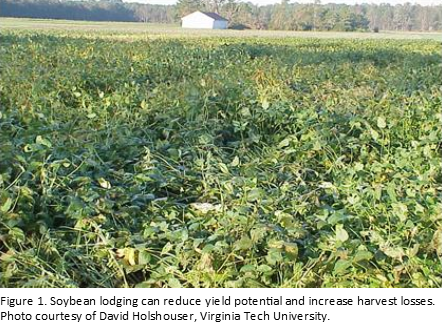- Soybean lodging can reduce yield potential and increase harvest losses.
- Lodging can reduce yield potential by interfering with pod set and pod fill, as well as reducing soybean harvestability.
- Selecting soybean products with good standability ratings and avoiding overplanting can help reduce soybean lodging.
Lodged soybean plants can reduce yield potential and increase harvest losses. In studies comparing simulated plant lodging with artificially-supported lodging, losses ranged from 0 to 30% depending on the severity of lodging and the growth stage when lodging occurred.1 Lodging during vegetative or reproductive growth can disrupt light penetration into the plant canopy and may reduce seed yield (Figure 1). Pod and stem diseases may also become more problematic on lodged soybean plants. Lodging late in the season may reduce harvest efficiency and increase harvest losses. Harvest losses due to soybean lodging can vary from 3 to 10% depending on a variety of factors.2

Soybean Lodging Causes
Environment. Moist, fertile soils may increase vegetative growth in soybeans and can lead to tall, leggy plants that are prone to lodging.
Soybean population. Soybean yield potential may increase, up to a point, with increasing plant population. However, soybean plant populations can vary widely without significant yield loss. Overplanting, especially when soybean seed is drilled, can cause plants to lodge because plants grow taller and more slender as they compete for light.
Soybean stem borer. The soybean stem borer is also commonly referred to as the Dectes stem borer. Larvae are legless, creamy white or yellow in color, and have an “accordion-like” appearance (Figure 2). Larvae can move into the main stem of a soybean plant where they can tunnel into the plant as it matures or girdle the stem. Significant soybean yield losses generally occur from larval girdling, which can result in lodging and harvest losses. Lodging is typically most severe in earlier planted soybean plants.
 Figure 2. Soybean stem borer
Figure 2. Soybean stem borer
Management
Soybean products differ in their susceptibility to lodging. If lodging has been a problem in the past, consider selecting soybean products with good standability ratings in addition to re-evaluating the seeding rate at planting.
Planting longer season soybeans can help to minimize harvest losses from lodging. Observations have shown that early planted, short-season soybean plants may be more prone to lodging as a result of soybean stem borer damage.3,4 Soybean cyst nematode (SCN) resistant soybean products can also be less susceptible to lodging compared to SCN susceptible products.5

Harvesting Considerations
Lodging slows down harvest operations and can lead to harvest losses as lodged plants are more difficult to cut and gather into the combine.
Harvest losses can be minimized by carefully adjusting and operating combines. Always refer to the manufacturer’s manual before performing any maintenance. The following harvest adjustments can help reduce harvest losses when combining lodged soybean plants:
- Maintain a ground speed of 3 miles per hour or less.
- Position the cutter bar as close to the ground as possible.
- Set the speed of the reel to run 25 percent faster than the ground speed. If soybean plants have significant lodging, increase the reel speed up to 50 percent faster than the ground speed.
- Position the reel axle 6 to 12 inches ahead of the cutter bar. Ideally, the reel should leave the soybean plants just as they are being cut. Set the height of the reel just low enough to control the soybean plants. In lodged conditions, operate the reel as low as necessary to pick up the plants.
Sources:
1Woods, S.J. and Swearingin, M.L. 1977. Influence of simulated early lodging upon soybean seed yield and its components. Agronomy Journal. 69: 239-242.
2Holshouser, D. 2011. Hurricane Irene may be beneficial to Virginia soybeans… still lodging will lower yield potential. Virginia Cooperative Extension. http://blogs.ext.vt.edu/
3Wright, R.J. and Hunt, T.E. 2011. Soybean stem borers in Nebraska. University of Nebraska-Lincoln Extension. G2082. http://www.ianrpubs.unl.edu/
4Whalen, J. and Cissel, B. 2014. Dectes stem borer management in soybeans. University of Delaware Cooperative Extension. IPM-7. http://extension.udel.edu/
5Staton, M. 2011. Reducing soybean harvest losses. Michigan State University Extension. http://msue.anr.msu.edu/
Web sources verified 07/17/15.
